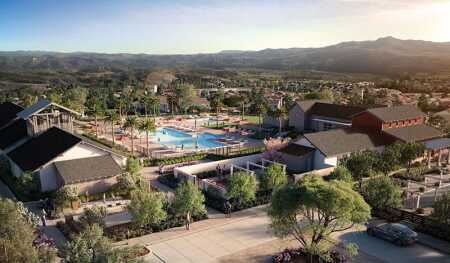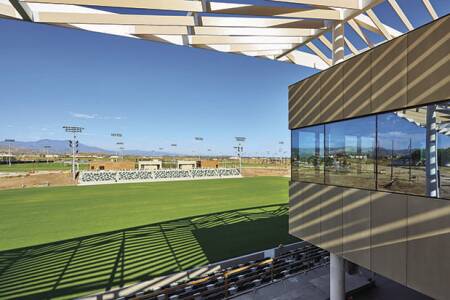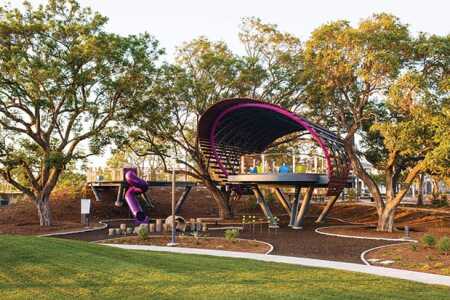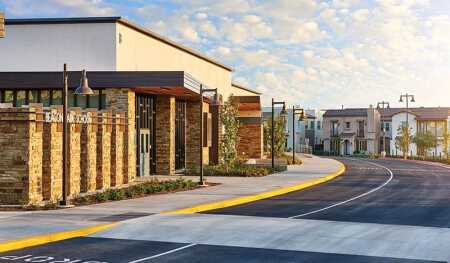With new homes loaded with high-end features, resort amenities, and open space—as well as access to good jobs, schools, beaches, shopping, restaurants, and entertainment—master-planned communities (MPCs) have put Orange County, California, at the top of the national MPC rankings.
Irvine Ranch in Irvine pulled ahead of the Villages in Ocala, Florida, to become the top-selling MPC in the United States in 2016. Three other Orange County MPCs—Great Park Neighborhoods in Irvine, Rancho Mission Viejo in south Orange County, and Baker Ranch in Lake Forest—ranked among the top 20 MPCs nationwide, according to two national surveys, from Irvine-based John Burns Real Estate Consulting and Washington, D.C.–based RCLCO.
Irvine Ranch and Great Park Neighborhoods are adjacent to each other, and Baker Ranch is a mile (1.6 km) away, notes Pete Reeb, principal of John Burns Real Estate Consulting.
“They do try to differentiate in terms of feel of amenities and architecture of neighborhoods, but from locational standpoint, they’re very similar,” Reeb says. “They’re all offering multiple neighborhoods; townhomes; small-lot, single-family detached, alley-loaded traditional homes. They overlap in density, size, and price.”
Rancho Mission Viejo, which is 20 miles (32 km) to the south, offers similar homes, but at lower price points because of its distance from key attractors, such as the greatest concentration of jobs and the county’s top school districts, he says.
These four hottest-selling Orange County MPCs have the advantage of being near high-paying jobs in sectors such as technology, biotech, finance, health care, aerospace, and higher education to attract the region’s highly educated workforce. Several were master-planned on legacy family ranches or farms and are being developed as amenity-rich suburban-style communities of for-sale homes.
Two have no village center but have access to retail centers on their perimeter. A third is building a neighborhood-serving commercial center, and a fourth is evolving with a more urban town center, greater density, and housing that is more diverse both in choices and makeup of households, as well as affordable. All four demonstrate that factors such as high land values, high construction costs, and a desire among many buyers for social communities have led to the creation of neighborhoods that are more compact and connected, with paths and trails that create a walkable and bikeable environment.
All have also developed market-rate homes with a mix of housing types that encourages sales to many types of buyers and at multiple price points. Options among the four communities range from starter condominiums, flats, and townhouses costing $400,000 to large, single-family luxury homes on big lots that can cost up to $3 million.
Add in homeowners association (HOA) fees to pay for community amenities and maintenance, and that can add up to a hefty monthly mortgage payment for homebuyers—if they have a mortgage, which many cash-flush MPC buyers do not.
While these prices are high compared with housing in other parts of the United States, they hit a broad sweet spot within the growing Orange County housing market, where the entry-level median purchase price is $630,887, according to a 2016–2017 Orange County Workforce Indicator report.
Who is buying these relatively expensive homes? Many homebuyers come from southern California, including Orange County. But a large percentage of buyers are international. The county’s population increased by 48,503 from 2010 to 2015, in large part due to an influx of immigrants, according to the county workforce report.
“Offshore money”—especially cash investments from China, Korea, India, and other Asian countries—“is driving many sales,” says John Martin, founder of John Martin Associates and an MPC consultant. The foreign money “has increased the demand for housing and upward prices,” notes Reeb.
The target markets for these MPCs vary according to the particular flavor of the community. They are attracting broad age ranges, from millennials to baby boomers, the developers say. Active seniors are attracted to all-ages communities, as well as to age-restricted 55-and-older neighborhoods integrated into communities. As market pressures continue to escalate—with the rising population increasing housing demand and prices, triggering a shortage of affordable housing—a couple of the MPC developers have built affordable housing off site in response to incentives, and one, Great Park Neighborhoods, as a key aspect of its community’s diversity, is developing homes on site that are affordable to lower-income households.
“Land is so expensive, and construction costs so high, the only way to provide product is to go to higher densities—such as 20 to 30 units per acre—to bring down the per-unit land cost and provide a more attainable cost,” says Reeb. “But even with that, starter homes are in the $400,000-to-$600,000 range for a two- to three-bedroom, two-and-a-half-bath home. We see that in all four of these MPCs.”
MPCs and builders that offer attached homes are doing very well, says Martin. “They’re building at a price point millennials can afford, with many amenities and social programs, which are attracting them.” In MPCs, buyers “might not want to live wall-to-wall, in dense high-rises,” he says, but are drawn to townhouses and moderately higher-density condominiums placed on “motor courts” with small private yards or rooftop decks and a shared driveway.
What are the specific drivers for these MPCs? Award-winning schools are the top attraction for families. Proximity to jobs is critical, as is easy regionwide access via the freeways. Also important are trails and resort-style amenities such as pools, recreation centers, sports fields, community kitchens, entertainment spaces, and social programming.
Diversity in housing choices is also key: from singles to large extended families, MPC developers are aiming to attract a broad range of homebuyers by providing different home sizes, building types, layouts, and architectural styles.
The following is a summary of what each of these top four Orange County communities offers and how they differentiate themselves in the market.
Irvine Ranch
In 2016, both John Burns Real Estate Consulting and RCLCO identified Irvine Ranch, specifically the Villages of Irvine, as the top-selling master-planned community in the United States. Master developer the Irvine Company sold 1,989 homes in 2016, a 19 percent increase over 2015, according to RCLCO. Founded in 1864, the Irvine Company is one of the largest and most diversified privately held real estate development companies in the United States. Its focus is on California from San Diego to Silicon Valley, including master planning and development for the city of Irvine.
In the early 1960s, the Irvine Company started to master plan and develop the ranch, which stretches from the Santa Ana Mountains to the Pacific Coast. The first of 25 villages opened several years later. More than 60 percent of the ranch’s 93,000 acres (37,600 ha), including foothills, meadows, oak canyons, and sandy beaches, is permanently preserved as open space. The 3.5-mile (6 km) Jeffrey Open Space Trail links village residents to more than 16,000 acres (6,500 ha) of permanently protected parkland and open space, and to the 22-mile (36 km) Mountains to Sea Trail, the backbone of the ranch’s extensive parks, trails, and open space.
Irvine Company is developing six villages, which are being promoted for their access to acclaimed school districts, location in one of America’s safest cities, easy access to freeways, and open space and recreational opportunities. High-end amenities include the Resort at the Groves, which has a junior Olympic-sized pool, a wading pool, a spa, tennis courts, and a fireplace.
The newest section, Eastwood Village, has ten neighborhoods, a new public elementary school, and a nearby retail center developed by the Irvine Company with shopping, restaurants, and services, including a Trader Joe’s grocery, a Home Depot, a fitness gym, and a Starbucks coffee shop.
Eastwood Village’s Delano townhouses, built by Brookfield Residential Southern California, start at $700,000 for a 1,500-square-foot (139 sq m), three-bedroom, two-bath home. At the high end, a Toll Brothers’ home in the Alta Vista neighborhood of Orchard Hills Village, with views of the Pacific Ocean, could cost up to $3 million for about 7,200 square feet (669 sq m) of space, including nine bedrooms and nine baths. Floor plans can include a great room, a first-floor parent suite in addition to a second-floor master suite with a sitting area and spa bathroom, two luxury outdoor living spaces, and dual two-car garages flanking an entry court.
Baker Ranch
Baker Ranch sold 443 homes in 2016, according to the national MPC surveys. Located next to the foothills of the Santa Ana Mountains, Baker Ranch belonged to the Baker family until 2008, when Shea Properties purchased the 387-acre (157 ha) site, located in the fly zone for the former Marine Corps Air Station El Toro (which had restricted land uses), to develop commercial projects.
When the city of Lake Forest approved residential development in 2012, Shea Homes became managing partner and was joined by the Toll Brothers as master developer. They have closed on 1,022 of 1,752 planned homes in 18 neighborhoods, with another 400 homes under construction and the rest targeted for completion by late 2019.
Eleven community and neighborhood parks, designed by San Clemente–based C2 Collaborative, support an active and healthy lifestyle. These include a popular dog park and the half-mile-long (0.8 km) Promenade Park, where concerts and other community events are held. Village One, the first neighborhood, which opened in 2014, has a community park with a sports field, ball courts, and playgrounds dedicated to the city for public use. All homes are no more than a five-minute walk from a community pool or recreation center.
The Grove, with a 6,500-square-foot (600 sq m) clubhouse, includes a lagoon-style family pool and water play area, a quiet pool and spa, an event room, a community kitchen, and outdoor entertaining space. The community also has a 10,000-square-foot (930 sq m) perimeter retail center with a Starbucks, a Montessori preschool, and several restaurants, located across from a large shopping center with a major grocery store.
“Baker Ranch has been successful in capturing new homebuyers looking for a location close to jobs with great schools in a resortlike setting, but at slightly lower price points than homes in nearby Irvine,” Reeb noted in the 2016 John Burns MPC report.
Homebuyers are attracted by the amenities, lower HOA fees, and the absence of additional taxes imposed at many MPCs to pay for infrastructure in Mello-Roos community facilities districts, says Karen Ellerman, vice president of sales and marketing for Shea Homes. (In response to 1978’s Proposition 13 limiting the ability of local public agencies to increase property taxes, 1982 legislation allowed establishment of Mello-Roos community facilities districts to finance public improvements and services.) Compared with other MPCs in the region, she says, “our monthly mortgage is less. You can get more home for your money, or you can buy a higher-priced home.”
One of the most popular home types is the motor-court home; 87 have been sold so far, says Ellerman. The Courts by Shea Homes, for example, are two- and three-story townhouses with open floor plans and outdoor living space. The 1,760-square-foot (165 sq m) homes, which have three bedrooms and two and a half baths, are priced in the low $600,000s.
“Outdoor living spaces are important to buyers now,” adds Ellerman. “What’s equally important is low maintenance. Some homeowners have come from homes with pools, and they don’t want that maintenance. They appreciate that [Baker Ranch] is lush, complete, not crowded, and they can meet with their neighbors and friends” at pools, parks, and trails.

The Reserve at Rancho Mission Viejo encompasses 17,000 acres (6,900 ha) of open space permanently protected for scientific research and natural habitat maintenance, as well as a public education and access program for local schools, docent-guided hikes, and special events. (Rancho Mission Viejo LLC)
Rancho Mission Viejo
Rancho Mission Viejo, also known as the Ranch, spans 23,000 acres (9,000 ha) of hills and canyons on Orange County’s last working cattle ranch and farm, which have been owned and operated by the O’Neill-Moiso family since 1882. California’s largest new master-planned community, developed by the family firm, Ranch Mission Viejo LLC, sold 458 homes in 2016 in its second village, Esencia, which opened in 2015. This represents a 52 percent increase over 2015, attributed to sales of homes under $600,000 to buyers age 55 and older.
The Ranch encourages a sense of stewardship of the land and its agricultural history through participation in a community farm program, as well as about 17,000 acres (7,000 ha) of permanently protected open space, known as the Reserve. The private reserve’s primary mission is to promote biodiversity through scientific research and natural habitat maintenance. It also manages a public education and access program involving local schools, docent-guided hikes and wildflower walks, and events for scout groups and other organizations.
The remaining 6,000 acres (2,400 ha) are planned for mixed-use, intergenerational villages with 14,000 homes, including 6,000 primarily single-story homes for residents age 55 and older. The 690-acre (270 ha) village of Sendero, which in 2013 was the first village to open, established an integrated model for intergenerational living with the gated Gavilán enclave of homes and amenities for residents at least 55 years old, surrounded by neighborhoods intended for all ages.
The village of Esencia’s Hilltop Neighborhoods, with views of the Pacific Coast, include 2,740 homes in 36 neighborhoods, about one-third of which are nongated neighborhoods for those 55 and older. The intergenerational model is designed for residents who “wish to live close to adult kids and grandkids,” and for “young-at-heart” seniors who enjoy mixing with people of all ages while also having exclusive access to their own pools, fitness facilities, and other amenities, says Paul Johnson, senior vice president for community development.
A focus on aging-in-place housing for older residents is important: the age-55-and-older cohort increased from 17.7 to 25.6 percent of the county population from 2000 to 2015 and is growing much faster than other age categories, according to the county workforce indicators report, while numbers in the working-age and younger populations are simultaneously declining.
MPCs in general “are trying to figure out now how to get more baby boomers to move,” says Martin. “They don’t have to, and it’s discretionary unless they physically need a one-level home.” Rancho Mission Viejo, he says, is excelling at providing appropriate aging-in-place homes that are not isolated in age-restricted communities.
For younger residents, the community is developing sites for schools, parks, playgrounds, and athletic fields; miles of trails; community farms; and clubhouses with pools, fitness centers, and special-event facilities. A mixed-use village center, Sendero Marketplace, is designed for higher density with 200 apartments and 95,000 square feet (8,800 sq m) of neighborhood-serving retail space, including a Gelson’s grocery store, a pharmacy, a bank, a gas station, and a medical office building. “We’re approaching development knowing we need to build all the complements of a city . . . so it can be self-sufficient,” says Johnson.
Homes range from Meritage Homes’ 931-square-foot (87 sq m) one-bedroom, one-and-a-half-bath Sage home for just over $400,000, to TRI Pointe Homes’ 3,765-square-foot (350 sq m), four-bedroom, five-and-a-half-bath Aubergine home for $1.3 million. Gavilán’s age 55-and-older homes range from William Lyon Homes’ 1,456-square-foot (135 sq m), two-bedroom, two-and-a-half-bath home for $622,000 to Shea Homes’ 2,590-square-foot (274 sq m), two-bedroom, two-and-a-half-bath Alondra home for nearly $1 million.
Great Park Neighborhoods
Located at the edge of the Orange County Great Park in Irvine, the Great Park Neighborhoods ranked second among the county’s MPCs in sales in 2016. The MPC sold 530 homes, an increase of 88 percent over 2015, driven by strong sales to homebuyers from Asia, according to RCLCO. The 2,000-acre (186 sq m) mixed-use community is planned for 9,500 homes in eight neighborhoods and about 4.9 million square feet (455,000 sq m) of commercial space.
Developer FivePoint Holdings in Aliso Viejo, California, one of the largest owners and developers of mixed-use communities in coastal California, is developing Great Park Neighborhoods with a brand that pivots from traditional MPCs to a more diverse and urban community. In 2005, Miami-based Lennar Corp. bought the former El Toro military base, and rezoned and began master planning the site, demolishing 2,000 buildings to prepare for community development.
Lennar donated the land for the park and $200 million in developer fees to the city of Irvine to build the 1,300-acre (526 ha) Orange County Great Park. FivePoint, which in 2009 took over development of Great Park Neighborhoods, also agreed to build half the park, at an estimated cost of $250 million. In August, FivePoint opened the first phase of the Great Park Sports Park, with a 5,000-spectator soccer stadium, six natural-sod soccer fields, 25 tennis courts, beach volleyball courts, and a large playground. The sports park will be turned over to the city to own and operate. A 12,000-seat amphitheater, built with partner Live Nation, is expected to be completed in October, with other park elements due in the second phase.
Donating the land and paying for development of the park “was the right thing to do, and in the end these amenities create value for us” and help establish the project’s lifestyle, says Emile Haddad, chairman and chief executive officer of FivePoint Holdings.
Base Camp, a European-style, vertically mixed-use village center, is planned for an area next to the sports park and will include two hotels, two office buildings, restaurants, a food hall, stores, and homes placed above retail space. Construction of the 250,000-square-foot (23,000 sq m) first phase is scheduled to begin next year.
The community is designed for healthy and sustainable living. When the residents move in, each household receives an orange cruiser bike, intended for exercise and to connect neighbors physically and socially via paths and trails.
FivePoint saved hundreds of heritage trees from the military base and transplanted them in neighborhood parks and other prominent places to lend a leafy, earlier-era feel to the project. Gardens and greenhouses, wellness programs, and classes offered by a local ecology center all focus on healthy and sustainable living, as do home features like solar panels and tankless water heaters.
The home design has been adjusted on the basis of market demand. In Pavilion Park, which opened as the first neighborhood in 2013, 70 percent of the buyers came from east Asia and China, and their cultural preferences to have in-laws living in the home rather than in planned lock-off suites prompted a design shift to feature a second master bedroom, located on the main floor.
Two neighborhoods, Beacon Park and Parasol Park, opened early this year. Both being developed by FivePoint major shareholder Lennar, they offer a denser, more urban lifestyle, with condominiums and townhouses.
The recently opened Beacon Park School, offering kindergarten through eighth grade, and Portola High School, and amenities such as a resort-style pool and a tree house at Beacon Park and a greenhouse and zip line at Parasol Park, are aimed at active younger households with kids. Both neighborhoods also have multipurpose sports courts, playgrounds, and tot lots. A dozen homebuilders are represented in homes that range from the high $500,000s for Tri Pointe Homes’ 1,400-square-foot (130 sq m), two-bedroom townhouse, to upward of $1.8 million for Calatlantic’s 4,400-square-foot-plus (410 sq m) five-bedroom home.
Economic diversity extends throughout the community, in which affordable apartments are embedded on blocks with market-rate homes. In 2015, in partnership with Irvine-based Related California, FivePoint opened Solaira at Pavilion Park, which has 221 affordable one- and two-bedroom apartments with supportive services for adults age 55 and older to live independently. Two affordable family rental communities, Luminaira and Espaira at Beacon Park, are to open this fall. A total of 1,056 affordable units will be developed by buildout in 2020.
“Our brand is to focus on mixing uses, income levels, generations, ethnic groups,” says Haddad. “We believe that no community is sustainable unless it’s inclusive and diversified.” FivePoint’s goals for Great Park Neighborhoods include developing market-rate housing at half the cost of the county’s median home through innovative design so that several generations of families at a range of income levels can live in the same community with access to good schools, parks, and sports and entertainment venues.
As long as drivers such as jobs continue to draw people to Orange County and foreign buyers continue to buy homes there, these four MPCs show promise of continued success—while they still have land to develop and as they evolve with the desires of the market.









